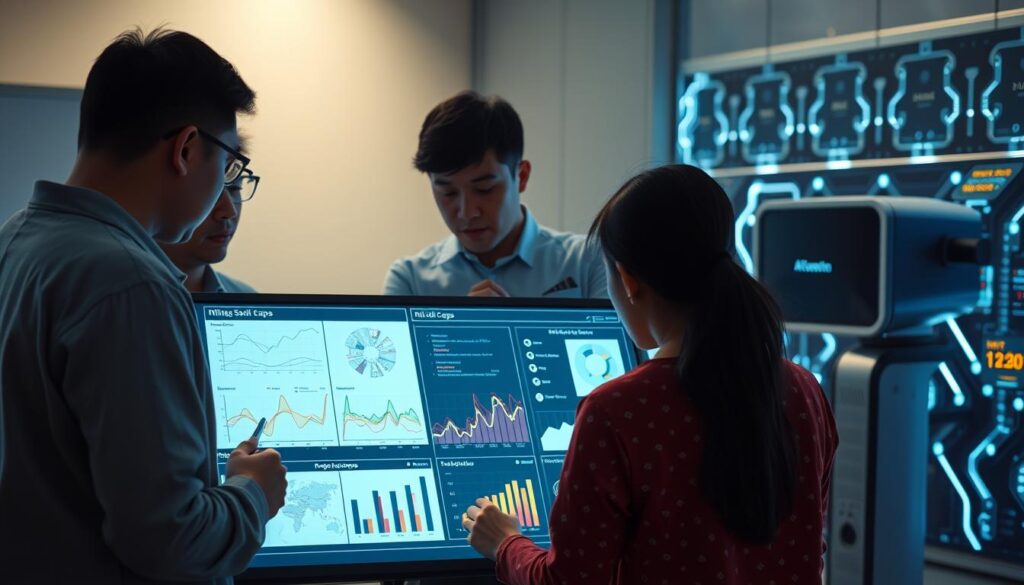Ever thought about how your company can find and fix skill gaps to boost efficiency? In today’s fast business world, skill gap analysis is key. It helps teams have the right skills to succeed. This article explores how AI changes skill gap analysis, helping teams grow stronger with AI.
As AI skills become more important, knowing how to use them can greatly improve work. It can make employees more engaged and help manage performance better.
Key Takeaways
- Skill gap analysis is essential for identifying discrepancies in employee skills.
- AI significantly enhances the effectiveness of skill gap analysis.
- Addressing skill shortages is vital for optimal team performance.
- AI workforce skills can lead to improved employee engagement.
- Businesses leveraging AI see enhanced decision-making capabilities.
- Understanding these dynamics can create a more agile workforce.
Understanding Skill Gaps in Today’s Workforce
Spotting skill gaps in the workforce is key for companies to tackle new challenges. With more tech, roles change, and skills must grow. In the Philippines, the need for skill checks is urgent, thanks to digital tech’s rise.
Importance of Identifying Skill Gaps
Finding skill gaps is vital for ongoing learning and bettering. Companies that check skills often stay ahead and stay competitive. If they ignore these gaps, they might face inefficiencies, high turnover, and missed growth chances.
Impact of Technology on Skills Requirements
Skills needed change fast with new tech like AI and big data. Knowing which skills are key for the future is essential. Regular checks help employees face new challenges and keep the company strong.
| Technology | Skills Required | Impact on Workforce |
|---|---|---|
| Artificial Intelligence | Data Analysis, Programming | Requires advanced tech literacy |
| Big Data | Statistical Analysis, Data Visualization | Increases demand for analytical skills |
| Cloud Computing | Cloud Management, Cybersecurity | Shifts focus to security and infrastructure management |
As companies grow, it’s vital to keep up with skill gaps and tech’s role in them. This ensures a skilled and flexible workforce.
The Role of AI in Skill Gap Analysis
AI changes how we look at skill gaps, making data collection and analysis better. It uses smart algorithms to quickly go through lots of employee data. This helps find out where skills are lacking.
Data Collection and Analysis
AI makes gathering and analyzing data easier. Old ways can’t handle big amounts of data well. AI gives real-time insights by combining data from different places.
This lets managers focus on what the data means and how to act. It helps businesses keep up with market changes and what their teams need.
Competency Mapping with AI
AI helps in making competency maps. These maps compare what employees can do with what’s needed in the job market. AI analytics show where teams are strong and where they need work.
It also looks ahead to see what skills will be needed next. This helps teams stay ready for new challenges.

Benefits of AI-driven Skill Gap Analysis
Companies are seeing the value of AI in analyzing skill gaps. This new method helps businesses make quick, smart choices. It changes how companies see their teams and improve their skills.
Faster Insights for Rapid Decision Making
AI gives companies fast insights, often in hours. This is key for quick changes in how they plan and develop their workforce. They can spot skill gaps fast, keeping up with market changes.
Managers can quickly look at data trends and act. This creates a culture that values being quick and ready.
Personalized Learning and Development
AI also helps in making learning plans for each employee. It finds out what each person needs, making training fit their goals. This makes training more relevant and keeps employees interested.
Custom learning paths help employees get the skills they need. This boosts both their growth and the company’s success.
Steps to Implement AI for Skill Gap Identification
Using AI to find skill gaps is a smart way to improve your team. It involves two main steps: figuring out what data you need and picking the right AI tools. A good plan helps you make choices that strengthen your team.
Assessing Data Needs
The first step is to check what data you need. You must look at *performance metrics*, *job descriptions*, and *competency evaluations*. This is crucial for getting useful insights.
It’s important to gather data from different sources. This way, you can see all aspects of your team’s skills and abilities.
Choosing the Right AI Tools
After knowing what data you need, it’s time to pick the right AI tools. Look for software that uses *natural language processing* and *predictive modeling*. Make sure these tools work well with your current HR systems.
Choosing the right technology helps you understand skill gaps better. This leads to better team development and growth.

Integration of AI Tools with HR Systems
Integrating AI tools with HR systems is a game-changer for companies. It helps them better understand their skill gaps. This is key for a clear view of what employees can do and what they need to learn.
By working together, companies can make better decisions and work more efficiently. This teamwork is essential for success.
Ensuring Data Flow and Efficiency
For AI and HR systems to work well together, data must flow smoothly. When this happens, companies get instant updates on how employees are doing. They also learn what skills are needed next.
This setup makes things run smoother and helps in planning training. It leads to a more skilled team.
The Importance of Seamless Integration
When AI tools and HR systems work together without a hitch, companies can automate important tasks. This means HR can focus on big-picture planning, not just paperwork.
This approach helps teams stay ahead in a changing world. It ensures they have the right skills to keep up with new challenges.
Training HR and Management Teams to Utilize AI
Training HR and management teams is key to using AI well. They need to understand the tech and learn to interpret AI insights. This helps them use AI dashboards and data visualizations to spot skill gaps and make smart choices.
Interpreting Insights from AI
Getting the most from AI insights requires training. HR pros must learn to pull out useful info from data. This way, they can spot trends and gaps in skills. Training in AI is crucial for better workforce planning.
Combining AI Insights with Human Experience
Using AI insights with human experience gives a deeper view of team dynamics. AI offers data, but human intuition and context are also essential. This mix improves decision-making and boosts workforce development.

Continuous Monitoring and Adapting Strategies
In today’s fast-changing business world, keeping an eye on skill gaps is crucial. This approach helps spot new gaps and makes sure workers have the right skills. It’s all about staying ahead of the game.
Establishing Feedback Loops
Feedback loops are key for companies to check if their training works. By regularly checking in, they find out what needs work. This lets them tweak their training plans on the fly.
Keeping Skills Relevant with Ongoing Training
Keeping up with the latest in your field is vital for staying competitive. Training that’s current and relevant helps close skill gaps. It also keeps employees eager to grow and learn.
| Training Aspect | Importance | Impact on Skills |
|---|---|---|
| Continuous Monitoring | Identifies skill deficiencies in real-time | Ensures employees have relevant skills |
| Feedback Loops | Regular assessments improve program effectiveness | Enhances training strategies based on actual performance |
| Ongoing Training | Aligns skills with industry trends | Prepares employees for future challenges |
Performance Management & Engagement
Effective performance management is key to aligning employee skills with company goals. This ensures the workforce is ready to tackle challenges and boosts team engagement. By addressing skill gaps, companies can motivate and satisfy their teams, leading to loyalty and better productivity.
Linking Skills to Organizational Goals
Connecting individual skills to company objectives gives employees a sense of purpose. When they see how their work contributes to the bigger picture, they become more committed. Training should focus on the skills needed to meet these goals. This approach promotes accountability and transparency, helping keep employees.
Enhancing Team Collaboration
Collaborative teams work more efficiently and effectively. Performance management should include ways to improve teamwork. This allows different skills to work together, fostering problem-solving and innovation. In the Philippines, teamwork is crucial, making these efforts even more important.
| Skill Area | Organizational Goal | Impact on Engagement |
|---|---|---|
| Communication | Improve customer satisfaction | Increased team cohesion |
| Project Management | On-time project delivery | Empowered employees |
| Technical Skills | Enhance product quality | Increased job satisfaction |
Real-world Examples of AI Skill Gap Analysis
In Asia, AI skill gap analysis is being used in new ways. It helps match the skills of workers with what the market needs. This approach is making workforce development better across the region.
Asian Companies Utilizing AI for Workforce Development
Many top companies in Asia are using AI to improve their training. For example, a big tech company has started AI-based training for new digital roles. These programs teach both technical skills and how to think critically and adapt quickly.
Case Studies from Southeast Asia
In Southeast Asia, AI is making a big difference in workforce development. A big bank has invested in digital training that uses AI to tailor learning to each employee. This way, workers can learn the skills they need for their careers, making the workforce stronger.
Challenges of Implementing AI in Skill Gap Analysis
Using AI for skill gap analysis comes with its own set of challenges. Knowing these obstacles early can make the transition smoother. It also helps in getting more support from employees and stakeholders.
The main hurdles include dealing with resistance to change and ensuring data privacy and security. Understanding these challenges is key to building a culture that accepts AI.
Overcoming Resistance to Change
Resistance from employees is a big challenge in AI skill gap analysis. When teams feel AI is a threat, progress slows down. Employees might worry about losing their jobs or not being able to keep up with new tech.
To ease these worries, creating a culture of openness is crucial. This means allowing employees to share their concerns openly. Offering training and clear communication about AI’s role can help reduce anxiety.
Data Privacy and Security Concerns
Data privacy and security add another layer of complexity. Ensuring compliance with laws like GDPR is essential. A detailed plan is needed to balance efficiency with protecting sensitive data.
This includes regular audits and clear policies that protect data and build trust. Strong data management practices create an environment where AI can thrive without compromising privacy.

| Challenge | Description | Solution |
|---|---|---|
| Resistance to Change | Employees’ fear of job displacement due to AI. | Open communication, training, and reassurance about the supportive role of AI. |
| Data Privacy | Concerns regarding the security of sensitive information. | Implementing compliance protocols and transparent data management strategies. |
Conclusion
AI is changing how we look at skill gaps in teams. It helps companies find and fix these gaps. This makes teams stronger and work better together.
Looking ahead, training and AI will go hand in hand. This is key for keeping up with new challenges. Companies in the Philippines and worldwide are using AI to stay ahead.
Using AI for skill gap analysis is more than just a smart choice. It’s about creating a culture of learning. This empowers employees and makes the whole organization stronger.

